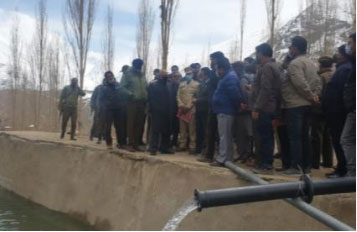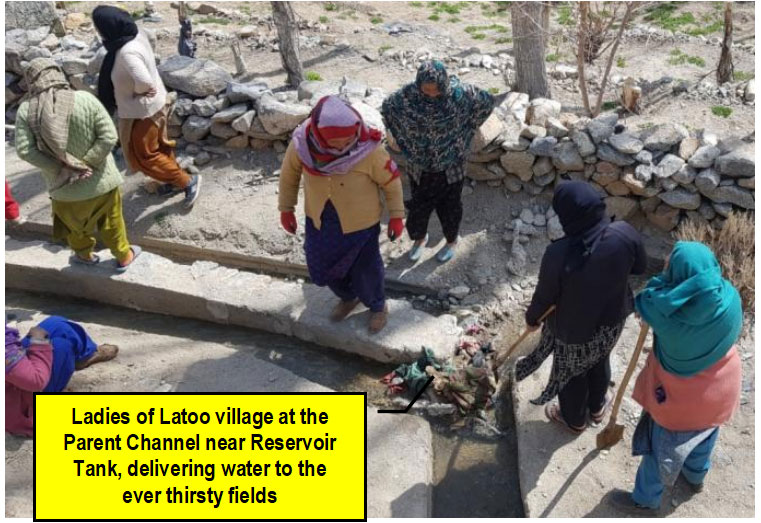Solar water lifting systems for irrigation have become increasingly popular as a sustainable and eco-friendly solution for farmers of Kargil. The Kargil Renewable Energy Development Agency (KREDA) has always been looking for energy efficient systems for the public of Kargil. The PV pumping system can efficiently manage water resources available for agricultural purposes in different zones of Kargil. KREDA has so far installed more than 11 nos. of Solar Pumping systems in different villages of Kargil Ladakh. These systems utilize solar energy to power water pumps, providing a cost-effective and reliable alternative to traditional diesel or electricity-powered pumps. Due to global warming and fast melting of glaciers the villagers from different regions of Ladakh have been reaching KREDA for sustainable solutions, as the old water storages, reservoirs in shape of glaciers, are melting year by year and also the region has been facing decline in snowfall. More than 70 villages have been enlisted in KREDA as drought prone areas. These villages face extreme water scarcity, especially during irrigation time, posing significant challenges for agricultural activities, livelihoods, and overall water security. In these regions, access to reliable water sources is critical for sustaining agricultural practices and ensuring the well-being of communities.
The very first village where KREDA introduced Solar Water Lifting Pump in Kargil was Latoo village located at the Line of Control (Border with Pakistan). This was the 1st ever high-capacity solar water lifting pump in Ladakh for irrigation purpose. The Goal of this project was to promote the use of Renewable Energy in Kargil by providing technical support in promoting solar based water lifting pumps. The objectives of the programme are given below:
Latoo village has sufficient and available/cultivable land which can be cultivated with efficient solar pumping system. But the necessary requirement of the system here raised because of the draught like condition in the LOC village of Latoo, all the apricot trees and fields had been facing shortage of water. Under this project, a solar water lifting system has been installed which will help in irrigating the ever parched land parcels of Latoo.
The pumping system, installed by Kargil Renewable Energy Development Agency (KREDA) is completely solar based submersible pump of 41Hp power. The system has a head range of 130-160 meter and will help in lifting 54 cum of water per hour.
A solar plant of capacity 50kWp has been installed to run the pumping system with all its energy for the whole day time. The pump is kept in a jack well, of size 3.35m x 2.10m x 3.65m, at the river bank and water is lifted through the delivery pipe of dia 140mm. The length of the pipe is about 360 meter.
 Considering the inherent advantages of such systems, development of such projects seems to be very effective and efficient way of distributing water at such draught facing places. It is important, for the sake of Kargil's continued prosperity, to promote Technology, especially Renewable Energy Based Projects and Programmes with the given land resource and environmental circumstances, so as to encourage a sound and sustainable future for the people of Ladakh region. The pump has not only provided relief from draught like situation in the area but also has helped the people in expanding the cultivated land area.
Many new land parcels have been irrigated and have cultivable thus increasing the production.
Considering the inherent advantages of such systems, development of such projects seems to be very effective and efficient way of distributing water at such draught facing places. It is important, for the sake of Kargil's continued prosperity, to promote Technology, especially Renewable Energy Based Projects and Programmes with the given land resource and environmental circumstances, so as to encourage a sound and sustainable future for the people of Ladakh region. The pump has not only provided relief from draught like situation in the area but also has helped the people in expanding the cultivated land area.
Many new land parcels have been irrigated and have cultivable thus increasing the production.
Latoo is the last village on Indian Border side, and is located just at the LOC. The project is meant for the purpose of developing a model water lifting project running on free energy, solar, which can also be used for an automatic micro irrigation system for supplying water at the proposed village. This scheme of solar pumping system installation shall be one of the best and successful schemes for this region.
This has also been recommended by KREDA that Micro Irrigation System (MIS) may be introduced in the village which could energize nearly 38 acres of
land. The expected and planned crops for drip shall be apricot, barley, apple, alfa-alfa etc.
Total identified land as cultivable uncultivated land is nearly about 15 acres. While there are 23 acres of land which is cultivated but due to
draught like conditions the land parcels are not cultivated properly. Water is one of the most critical inputs for the vegetable/ apricot/ apple
they grow at Latoo and its availability in adequate quantity and quality is key factors for achieving higher productivity levels.
 At this stage, the imperatives, which the whole region of Ladakh requires is to enhance the investments in conservation of water and
improved techniques. The prevailing, conventional irrigation system at the Latoo has been seen as inefficient. Therefore, there is a
need to shift the whole system of irrigation and adopt improved methods of irrigation such as drip and sprinkler.
One of the major requirements in irrigating the proposed fields at Latoo is adoption of water management practices.
The Latoo village has lots of land patches near the river as well as at the plateau with south facing.
Various options are available for reducing water demand in producing crops.
At this stage, the imperatives, which the whole region of Ladakh requires is to enhance the investments in conservation of water and
improved techniques. The prevailing, conventional irrigation system at the Latoo has been seen as inefficient. Therefore, there is a
need to shift the whole system of irrigation and adopt improved methods of irrigation such as drip and sprinkler.
One of the major requirements in irrigating the proposed fields at Latoo is adoption of water management practices.
The Latoo village has lots of land patches near the river as well as at the plateau with south facing.
Various options are available for reducing water demand in producing crops.
 KREDA is also planning of using the solar pumping system to supply drinking water with highly advanced pressure filtration systems and Ultraviolet purifications in future. The lifted and treated water shall meet all the BIS Drinking water standards. The proposal would be that the filtered water shall be stored in the latest ZINC /GALV Alume coated steel tanks with liners and is distributed through activated carbon chambers which are designed to supply water even at the winter.
KREDA is also planning of using the solar pumping system to supply drinking water with highly advanced pressure filtration systems and Ultraviolet purifications in future. The lifted and treated water shall meet all the BIS Drinking water standards. The proposal would be that the filtered water shall be stored in the latest ZINC /GALV Alume coated steel tanks with liners and is distributed through activated carbon chambers which are designed to supply water even at the winter.
The aim is to built up Water Kiosks in designated points for public uses and also provides individual houses connections controlled to 55 Litres of water per Capita / day. The system capacity is designed after understanding the growth of the population for next 20 years. The community driven water distribution programme has to be initiated to bring ownership to the assets which have been installed for this Village.
This introduction of PV pumping system by KREDA in Ladakh, especially of higher capacity, for irrigation purpose, has become one innovative solution to address the drought challenge. The implementation of solar water pumping systems, which utilize solar energy to pump water from underground sources or surface water bodies can help the drought prone villages to a large extend.
One of the key benefits of solar pumping systems for irrigation is their ability to harness solar energy, a renewable and abundant source of power in Ladakh. By using solar panels to capture energy from the sun, the villagers can reduce or even eliminate their reliance on fossil fuels, lowering their carbon footprint and contributing to a cleaner environment. Additionally, solar pumping systems require minimal maintenance and have a long lifespan of minimum 25years, making them a durable and cost-effective investment for agricultural operations.
Another advantage of solar pumping systems is their versatility and scalability. These systems can be easily installed in remote locations where access to electricity may be limited, providing farmers with a reliable source of power for their irrigation needs.
KREDA uses Variable Frequency drives and controllers to adjust the flow rate and pressure of the water, enabling precise control over irrigation timing and volume. This not only helps to conserve water but also improves crop productivity by ensuring that plants receive the right amount of water at the right time.
Despite the numerous benefits of solar water pumping systems, there are several implications that need to be considered while implementing these systems in drought-prone areas. One key consideration is the initial cost of installing solar water pumping systems, which can be high for resource-constrained communities, villages or hamlets of Ladakh. However, UT/Government subsidies, financial incentives, and innovative financing mechanisms can help reduce the upfront costs and make these systems more accessible to smallholder farmers and rural communities.
Another implication is the technical expertise required to design, install, and maintain solar water pumping systems in the far-flung villages of Ladakh. Renewable Energy Agencies of the MNRE GOI should be given responsibility for implementation of Renewable part in irrigation system, whereunder the solar module part can be executed through these agencies who are expert. Training programs and capacity-building initiatives can help build the skills and knowledge needed to operate these systems effectively and ensure their long-term sustainability.
Furthermore, the reliability and efficiency of solar water pumping systems can be influenced by factors such as weather patterns, solar irradiation, and water demand. Proper planning, site selection, and monitoring are essential to optimize the performance of these systems and ensure a consistent water supply for agricultural activities and community needs.
|
Total No. of Solar Pumps Installed in Kargil by KREDA under different Schemes: |
||||
|
|
|
|
|
|
|
S. No. |
Scheme Name |
PV Pumps installed in Kargil |
||
|
|
||||
|
S.No. |
Name of Villages |
Capacity |
||
|
1 |
Special Development Package of UT Ladakh |
1 |
Karsha Monestary Zanskar |
7.5 Hp/8kWp |
|
2 |
Remala Zanskar |
41Hp/40kWp |
||
|
3 |
Shilingskit Zanskar |
30Hp/30kWp |
||
|
4 |
Purney Zanskar |
20Hp/20kWp |
||
|
2 |
Under Other Schemes |
5 |
Latoo, Kargil |
41 Hp/50kWp |
|
6 |
Monmolung Khangral |
20 Hp/24kWP |
||
|
7 |
Adulgund, Kargil |
10 Hp/12kWp |
||
|
8 |
Santakshan, Chiktan |
7.5 Hp/9kWp |
||
|
9 |
Dargo, Chiktan |
7.5 Hp/9kWp |
||
|
10 |
Andoo, Kargil |
7.5 Hp/9kWp |
||